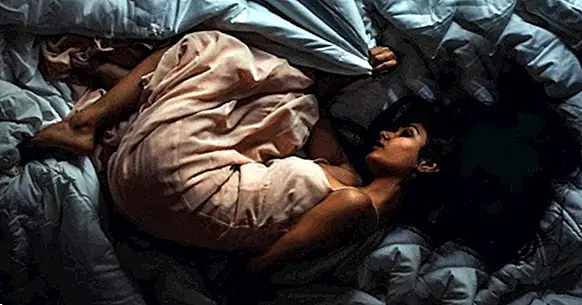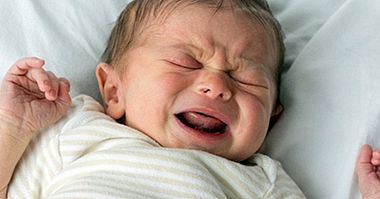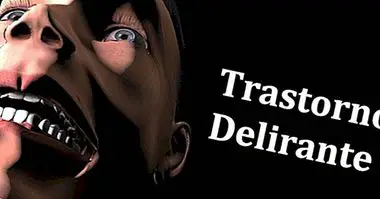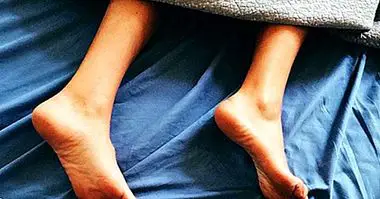REM sleep behavior disorder: symptoms and treatment
As a general rule, people's sleep cycles can be divided into several phases, specifically five. Four first phases that are characterized by presenting different wave patterns of sleep and the last phase known as REM sleep. This occupies between 15 and 20% of the natural sleep cycle and in it most of the daydreams occur, as well as muscular atony.
However, there are occasions when there is an alteration in this cycle, as it is in the case of conduct disorder during REM sleep . Throughout this article we will discuss the characteristics of this condition, as well as its symptoms, causes and treatments that can alleviate the effects of this disorder.
- Related article: "The 7 main sleep disorders"
What is conduct disorder during REM sleep?
Behavior disorder during REM sleep was first described in 1986, by the doctor and researcher Carlos H. Schenck , specialist in sleep disorders and behaviors. He defined it as a parasomnia of REM sleep; that is, a grouping of behaviors or abnormal phenomena that appear during this phase of the dream.
This type of sleep disorder or parasomnia, It is distinguished by affecting both the development of the dream and the motor system of the person . Causing the appearance of episodes of intense motor activity which affects various muscle groups.
These movements are manifested in the form of leg shakes, kicks, blows of fists and arms and even verbal manifestations like screams. Which can harm the person who accompanies you during your sleep.
The patient may even get out of bed , walk or walk in response to the dream activity that is experienced at that moment. The violence of these motor activities finds its explanation in the content of dreams, which are often described as unpleasant, aggressive and virulent.
The incidence of this disorder among the population is really scarce, being reduced to only 0.5% of it. However, on many occasions this is masked by other syndromes with similar clinical pictures . In a large number of cases it is misdiagnosed as a nocturnal convulsive disorder, consisting of a strange variety of obstructive sleep apnea syndrome.
In addition, this disorder is much more frequent in men, reaching to represent 90% of the cases of CRT and appearing, usually, between 50 and 60 years of age.
- Maybe you're interested: "REM sleep phase: what is it and why is it fascinating?"
What types are there?
Behavior disorder during REM sleep can manifest itself in two different categories: acutely, idiopathically or chronically .
The acute type of this disorder tends to be associated with periods of abstinence from alcohol. Especially in those people with a history of years of alcohol abuse. Similarly, certain drugs or medications such as hypnotic sedatives, anticholinergics or liposoluble blocking drugs can also cause this type of sleep disturbance.
Likewise, two more types of TCR have been identified. One of them consists of an idiopathic form of the disorder; that is, in which the TCR consists of a disease by itself not associated with other alterations or injuries and that may evolve over time becoming a form of neurodegenerative disease .
Regarding the chronic typology of the TCR, this is caused or is part of the clinical picture of a series of neurodegenerative diseases such as Parkinson's disease, Lewy body dementia, multisystemic atrophy or, to a lesser extent, supranuclear palsy. , Alzheimer's disease, corticobasal degeneration and spinocerebellar ataxias. In the same way, may be associated with disorders such as narcolepsy , injuries of the brainstem, tumoral formations and cerebrovascular accidents.
The symptomatology of this parasomnia
Within the clinical picture of conduct disorder during sleep, we find a state of lack of muscular atony that manifests itself in the form of abrupt and violent movements that appear at the beginning of the REM sleep phase and remain along it. These movements are an involuntary response to the content of daydreams that the patient lives, which describes them as vivid, unpleasant and aggressive.
In most cases, patients describe their dreams as an extremely unpleasant experience in which they represent all kinds of fights, arguments, persecutions and even accidents or falls.
In a percentage of patients, specifically in 25%, behavioral alterations during sleep prior to the onset of the disorder have been determined. Among these behaviors sleepwalking, screaming, fasciculations and seizures of the extremities are included .
In the case of behavioral or motor symptoms typical of this disorder are:
- Talk.
- Laugh.
- Shout.
- Curse or insult
- Gestures .
- Agitation of the extremities.
- Hits.
- Kicks
- Jumps or jumps out of bed .
- Run.
Due to the aggressiveness with which these behaviors appear, it is common for the patient to end up damaging or beating the person next to them, as well as causing self-harm. Among the damages that are inflicted both on the companion and oneself are lacerations, subdural hematomas and even fractures.
What is known about its causes?
The information obtained about the causes of the behavior disorder during REM sleep is quite scarce. In more than half of the cases, the cause of this condition is related to the future appearance of some type of neurodegenerative disease .
However, recent studies with animal models point to the possibility that there is a dysfunction in the cerebral structures of the pontine tegmentum, the locus coeruleus and the pedunculopontine nucleus; which are the main responsible for regulating muscle tone during sleep.
- Related article: "Parts of the human brain (and functions)"
Is there a treatment?
Luckily, there is a treatment for behavior disorder during REM sleep based on the administration of daily doses of clonazepam . With a dose of between 0.5 and 1 mg, administered before bedtime, and whenever the doctor indicates, it is very likely that the person will experience greater control of sleep disturbances, including a decrease in the amount and intensity of aggressive behaviors and violent dreams.
In patients who do not respond to clonazepam or who present some type of contraindication, it is possible to resort to the use of melatonin, pramipexole or donepezil for the cases described as refractory.
Regarding the prognosis of the disease, it is expected that with the pharmacological treatment an absolute remission of the symptoms will be achieved. However, there is no definitive cure for the TCR, so if the dose is lowered or the treatment is suspended the symptoms may reappear even more strongly .
It is necessary to specify that in cases where the TCR is caused by a neurodegenerative disease, the treatment with clonazepam is not effective, the patient having to follow a specific treatment for the main disease.



















